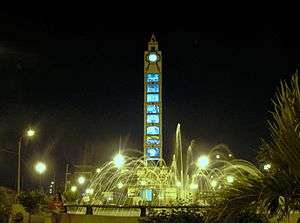Ucayali Region
| Ucayali Region | ||
|---|---|---|
| Region | ||
| ||
.svg.png) Location of the Ucayali Region in Peru | ||
| Coordinates: 9°58′S 73°11′W / 9.96°S 73.19°WCoordinates: 9°58′S 73°11′W / 9.96°S 73.19°W | ||
| Country | Peru | |
| Subdivisions | 4 provinces and 14 districts | |
| Largest city | Pucallpa | |
| Capital | Pucallpa | |
| Government | ||
| • President | Jorge Velásquez Portocarrero | |
| Area | ||
| • Total | 101,830.64 km2 (39,317.03 sq mi) | |
| Elevation(Capital) | 120 m (390 ft) | |
| Highest elevation | 350 m (1,150 ft) | |
| Lowest elevation | 135 m (443 ft) | |
| Population (2007 census) | ||
| • Total | 432,159 | |
| • Density | 4.2/km2 (11/sq mi) | |
| UBIGEO | 25 | |
| Dialing code | 061 | |
| ISO 3166 code | PE-UCA | |
| Principal resources | Wood, fruit. | |
| Poverty rate | 70.5% | |
| Percentage of Peru's GDP | 0.85% | |
| Website | www.regionucayali.gob.pe | |
Ucayali is an inland region in Peru. Located in the Amazon rainforest, its name is derived from the Ucayali River. The regional capital is the city of Pucallpa.


Geography
Boundaries
The Ucayali Region is bordered by the Brazilian state of Acre on the east; the region of Madre de Dios on the southeast; Cusco on the south; Junín, Pasco and Huánuco on the west; and Loreto on the north.
Demographics
Population
According to the 2007 Census, the Ucayali Region has a population of 432,159 inhabitants, 51.4% of which (222,132) are male and 48.6% (210,027) are female. 75.3% of the population (325,347) live in urban areas while the remaining 24.7% (106,812) live in rural areas.
As of 2002, the Instituto Nacional de Estadística e Informática estimated the region's population to be 468,922.
Languages
Spanish is spoken as a first language by 87.6% of the population, while 4.1% speak Asháninka, 1.5% speak Quechua and 0.1% speak Aymara. Other indigenous languages, including Shipibo, are spoken by 6.6% of the population and 0.0% speak foreign languages.
Immigration
Persons originating from other regions of the country make up 34.7% of the population and 0.2% of residents were born abroad.
The largest immigrant groups come from the Loreto Region (12.5% of the total population).
Age
The population is spread out with 53.9% under the age of 20, 9.3% from 20 to 24, 25.4% from 25 to 44, 8.8% from 45 to 64, and 2.5% who are 65 years of age or older.
Education
Secondary education has been attended by 29% of the population and 2.3% also have graduated from non-university higher education, while 1.7% have complete university studies. 49.3% only have attended primary education and 9.1% have not had any education.
The illiteracy rate in the region is 14.2%
Political division
The region is divided into 4 provinces (Spanish: provincias, singular: provincia), which are composed of 14 districts (distritos, singular: distrito).
Provinces
The provinces, with their capitals in parentheses, are:
Places of interest
External links
- (Spanish) Gobierno Regional de Ucayali - Ucayali Regional Government website
